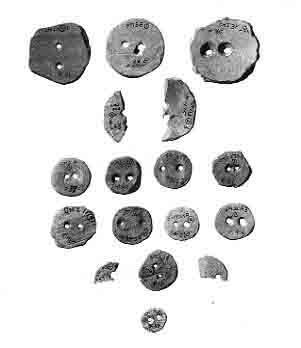Image Details

Courtesy Gus Van Beek
Enigmatic discs. While excavating at Tell Jemmeh in Israel, Dr. Gus Van Beek of the Smithsonian Institution discovered these 17 small discs and disc fragments. Made from potsherds and perforated with two drilled holes near the center (in the complete examples), these discs were dated by their contexts from Late Bronze II to the early Hellenistic period, or about 1400 to 152 B.C. They exhibit a large variation in size, but seem to fall into three groups, as arranged in the photo. The top two rows show the large discs and fragments, which have diameters ranging from 1.7 to 2.1 inches. The next three rows from the top contain discs ranging from 1 to 1.4 inches in diameter. A single disc in the bottom row represents the third group and has a diameter of .8 of an inch.
Such discs have been found at other sites in Israel, as well as in Lebanon, Egypt and India. In the past, archaeologists have called them “buttons” or “perforated discs,” but their function is not really known. Recently Van Beek proposed that they may be a traditional toy, called a “buzz,” known even today.
